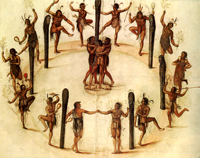Watercolours by John White
Huon Mallalieu enjoys a rare display of John White's influential views of America at the British Museum


The headline of this article is not just the obvious quote it is particularly apposite for the British Museum's exhibition of Virginian watercolours by John White (about 1543?1606). In 1587, White's granddaughter, Virginia Dare, was the first English child to be born in the New World. She disappeared shortly afterwards with Walter Raleigh's 'Lost Colony', but at the time of the Jamestown settlement in 1607, the rumour that she had survived in captivity was an ingredient of Shakespeare's Miranda in The Tempest.
There is another link to The Tempest, apparently overlooked by scholars. The account of the 1584 voyage (which White accompanied), published by Hakluyt in 1589, contains a passage that directly inspired parts of Gonzalo's 'Had I plantation of this isle' speech (Act II, scene I, 145 et seq). White had gone to England for help. The Armada prevented him from going to the rescue until it was too late. All certain facts of White's life lie between 1584 and 1593, although he may have been in Ireland in 1567?8, and perhaps survived until 1606. It is not known who taught him the technique of limning, or watercolour painting. He made five voyages to North America, at first to record, and later as Governor of the 'Cittie of Raleigh in Virginia'. He was not the first European to paint the New World, but he had the most influence on European ideas of Native Americans.
The drawings became known through Theodore de Bry's engravings, illustrating the text by White's fellow recorder, Thomas Harriot, A briefe and true report... of Virginia, 1590. The book accompanying the exhibition, by Kim Sloan and others, makes the point that White's drawings are not only accurate portraits of the people and customs, but carefully constructed propaganda for the plantation project.
Certainly, part of White's practice of creating, in his words, 'pictures of sondry things collected and counterfeited according to the truth' was to sell this paradise to the Government, colonists and potential investors, but Joyce E. Chaplain's essay perhaps overstates the case. Her statement that 'the word counterfeit implied, by his day, a kind of falsehood' is not quite true.
The word might imply falsehood, but it could also praise a perfect likeness, especially when used of limning. When Hamlet bids his mother 'Look here upon this picture and on that, The counterfeit presentment of two brothers,' he is not saying the miniatures are fake Hilliards; quite the contrary. This linguistic misunderstanding may have led to over-emphasis on political purpose, and too little regard for an important intellectual aspect of the late 16th century. The period was fascinated with the world's diversity, and assembled the first cabinets of curiosities. White's drawings and the engravings fitted such collections perfectly. Similarly, it is thanks to the assiduity of the great antiquary Hans Sloane that the surviving drawings, together with artists' copies, are in the British Museum.
There are maps, plans of fortifications, individual Indians (as White called them), groups, villages and activities, superb studies of fish, plants, birds and beasts, and several disparate-seeming subjects, such as a skirmish between English and Inuit, and figures of Turks, the last not done from life any more than various Ancient Britons and Picts.
The colours are mostly strong, and White's drawing is excellent although, in one, he endearingly gives a woman two right feet. He deserves to be much better known after all, he is in part responsible for such styles of our day as the punks' 'Mohican' hairstyle.
Exquisite houses, the beauty of Nature, and how to get the most from your life, straight to your inbox.
'A New World England's first View of America' is at the British Museum (020?7323 8181; www.thebritishmuseum.ac.uk) to June 17
Country Life is unlike any other magazine: the only glossy weekly on the newsstand and the only magazine that has been guest-edited by His Majesty The King not once, but twice. It is a celebration of modern rural life and all its diverse joys and pleasures — that was first published in Queen Victoria's Diamond Jubilee year. Our eclectic mixture of witty and informative content — from the most up-to-date property news and commentary and a coveted glimpse inside some of the UK's best houses and gardens, to gardening, the arts and interior design, written by experts in their field — still cannot be found in print or online, anywhere else.
